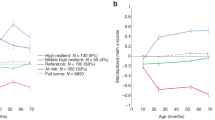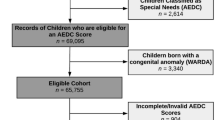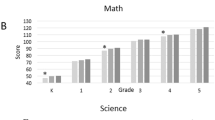Abstract
Background
Development of children born very preterm (VPT) is evaluated using the Bayley Scales of Infant Development. Early Bayley scores may not predict later outcomes. We studied whether VPT Bayley trajectories in the early years predicted school readiness better than single assessments.
Methods
We prospectively evaluated 53 VPT at 4–5 years using standardized measures of school readiness, including the domains of cognition, early mathematical and literacy abilities, and motor skills. Predictors were Bayley-III scores obtained 1–5 times/child between 6 and 35 months. Linear mixed models (LMM) with random effects extracted estimated random effect for slope (change in Bayley score/1 year) and fixed+random effect sum for the intercept (initial Bayley score) for each participant, to then evaluate 4–5-year outcomes prediction.
Results
Variability of individual trajectories prevailed across developmental domains. For the initial LMM, adding Bayley change to models with only initial score improved model fits for several Bayley-III domains. Models containing estimates for initial Bayley scores and Bayley change explained significantly more variability in school readiness scores (21–63%) than either variable alone.
Conclusion
Neurodevelopmental follow-up of VPT is more relevant to school readiness when children are assessed multiple times in the first 3 years. Neonatal intervention research could use early trajectories rather than single timepoints as outcomes.
Impact
-
This study is the first to examine individual Bayley scores and trajectories to predict school readiness of formerly preterm children at 4–5 years.
-
Modeling demonstrated extreme variability of individual trajectories compared to the group’s average trajectories.
-
Models containing initial Bayley scores and Bayley change over time explained more variability in preschool readiness than either variable alone.
-
Using the Bayley to predict future school readiness is enhanced by administration across multiple follow-up visits and inclusion of change across the first 3 years.
-
Follow-up care models and clinical trial design for neonatal interventions may benefit from a trajectory-based approach to outcomes evaluation.
This is a preview of subscription content, access via your institution
Access options
Subscribe to this journal
Receive 14 print issues and online access
$259.00 per year
only $18.50 per issue
Buy this article
- Purchase on Springer Link
- Instant access to full article PDF
Prices may be subject to local taxes which are calculated during checkout

Similar content being viewed by others
Data availability
Non-identifiable data are available on reasonable request for 5 years after the study conclusion from the corresponding authors.
References
Aylward, G. P. Neurodevelopmental outcomes of infants born prematurely. J. Dev. Behav. Pediatr. 35, 394–407 (2014).
Saigal, S. & Doyle, L. W. An overview of mortality and sequelae of preterm birth from infancy to adulthood. Lancet 371, 261–269 (2008).
Maitre, N. L., Lambert, W. E., Aschner, J. L. & Key, A. P. Cortical speech sound differentiation in the neonatal intensive care unit predicts cognitive and language development in the first 2 years of life. Dev. Med. Child Neurol. 55, 834–839 (2013).
Maitre, N. L. Neurorehabilitation after neonatal intensive care: evidence and challenges. Arch. Dis. Child. Fetal Neonatal Ed. 100, F534–F540 (2015).
Neel, M. L., Slaughter, J. C., Stark, A. R. & Maitre, N. L. Parenting style associations with sensory threshold and behavior, a prospective cohort study in term/preterm infants. Acta Paediatr. 108, 1616–1623 (2019).
Mustard, J. F. Experience-based brain development: scientific underpinnings of the importance of early child development in a global world. Paediatr. Child Health 11, 571–572 (2006).
Daelmans, B. et al. Early childhood development: the foundation of sustainable development. Lancet 389, 9–11 (2017).
Kilbride, H., Aylward, G., Doyle, L., Singer, L. & Lantos, J. Prognostic neurodevelopmental testing of preterm infants: do we need to change the paradigm? J. Perinatol. 37, 475–479 (2017).
Taylor, G. L. et al. Changes in neurodevelopmental outcomes from age 2 to 10 years for children born extremely preterm. Pediatrics 147, e2020001040 (2021).
Roberts, G., Anderson, P., Doyle, L. & Group, V. I. C. S. The stability of the diagnosis of developmental disability between ages 2 and 8 in a geographic cohort of very preterm children born in 1997. Arch. Dis. Child. 95, 786–790 (2010).
Marlow, N., Wolke, D., Bracewell, M. A. & Samara, M. Neurologic and developmental disability at six years of age after extremely preterm birth. N. Engl. J. Med. 352, 9–19 (2005).
Serenius, F. et al. Neurodevelopmental outcomes among extremely preterm infants 6.5 years after active perinatal care in Sweden. JAMA Pediatr. 170, 954–963 (2016).
Bode, M. M., D’Eugenio, D. B., Mettelman, B. B. & Gross, S. J. Predictive validity of the Bayley, at 2 years for intelligence quotient at 4 years in preterm infants. J. Dev. Behav. Pediatr. 35, 570–575 (2014).
Munck, P. et al. Stability of cognitive outcome from 2 to 5 years of age in very low birth weight children. Pediatrics 129, 503–508 (2012).
Hack, M. et al. Poor predictive validity of the Bayley scales of infant development for cognitive function of extremely low birth weight children at school age. Pediatrics 116, 333–341 (2005).
O’Shea, T. M. et al. Accuracy of the Bayley-II Mental Development Index at 2 years as a predictor of cognitive impairment at school age among children born extremely preterm. J. Perinatology. 38, 908–916 (2018).
Burakevych, N. et al. Bayley‐III Motor Scale and Neurological Examination at 2 years do not predict motor skills at 4.5 years. Dev. Med. Child Neurol. 59, 216–223 (2017).
Spencer-Smith, M. M., Spittle, A. J., Lee, K. J., Doyle, L. W. & Anderson, P. J. Bayley-III Cognitive and Language Scales in preterm children. Pediatrics 135, e1258–e1265 (2015).
Greene, M. M., Patra, K., Silvestri, J. M. & Nelson, M. N. Re-evaluating preterm infants with the Bayley-III: patterns and predictors of change. Res. Dev. Disabi. 34, 2107–2117 (2013).
Janssen, A. J. et al. Unstable longitudinal motor performance in preterm infants from 6 to 24 months on the Bayley Scales of Infant Development—Second Edition. Res. Dev. Disabil. 32, 1902–1909 (2011).
de Silva, A., Neel, M. L., Maitre, N., Busch, T. & Taylor, H. G. Resilience and vulnerability in very preterm 4-year-olds. Clin. Neuropsychol. 35, 904–924 (2021).
Taylor, H. G. et al. School readiness in 4-year-old very preterm. Child. Child. 9, 323 (2022).
Bayley, N. Bayley Scales of Infant and Toddler Development 3rd edn (PsychCorp, Pearson, 2006).
Elliott, C. D., Salerno, J. D., Dumont, R. & Willis, J. O. Differential Ability Scale 2nd edn (Harcourt Assessment, San Antonio, TX, 2007).
Lonigan, C. J., Wagner, R. K., Torgesen, J. K. & Rashotte, C. A. Topel: Test of Preschool Early Literacy (Pro-Ed, Austin, TX, 2007).
Henderson, S. E., Sugden, D. A. & Barnett, A. L. Movement Assessment Battery for Children-2 2nd edn (The Psychological Corporation, 2007).
Neel, M. L. et al. Exceeding expectations after perinatal risks for poor development: associations in term-and preterm-born preschoolers. J. Perinatol. 42, 491–498 (2022).
Dandis, R. et al. A tutorial on dynamic risk prediction of a binary outcome based on a longitudinal biomarker. Biom. J. 62, 398–413 (2020).
Wang, C., Wang, N. & Wang, S. Regression analysis when covariates are regression parameters of a random effects model for observed longitudinal measurements. Biometrics 56, 487–495 (2000).
Nelder, J. A. & Wedderburn, R. W. Generalized linear models. J. R. Stat. Soc. Ser. A (Gen.) 135, 370–384 (1972).
Spittle, A. J. et al. Does the Bayley‐III Motor Scale at 2 years predict motor outcome at 4 years in very preterm children? Dev. Med. Child Neurol. 55, 448–452 (2013).
Breeman, L. D., Jaekel, J., Baumann, N., Bartmann, P. & Wolke, D. Preterm cognitive function into adulthood. Pediatrics 136, 415–423 (2015).
dos Santos, E. S. L., de Kieviet, J. F., Königs, M., van Elburg, R. M. & Oosterlaan, J. Predictive value of the Bayley Scales of Infant Development on Development of very preterm/very low birth weight children: a meta-analysis. Early Hum. Dev. 89, 487–496 (2013).
Prechtl, H. F. R. State of the art of a new functional assessment of the young nervous system. An early predictor of cerebral palsy. Early Hum. Dev. 50, 1–11 (1997).
Hadders‐Algra, M. The assessment of general movements is a valuable technique for the detection of brain dysfunction in young infants. A review. Acta Paediatr. 85, 39–43 (1996).
Kwong, A. K., Fitzgerald, T. L., Doyle, L. W., Cheong, J. L. & Spittle, A. J. Predictive validity of spontaneous early infant movement for later cerebral palsy: a systematic review. Dev. Med. Child Neurol. 60, 480–489 (2018).
Evensen, K. A. I., Skranes, J., Brubakk, A.-M. & Vik, T. Predictive value of early motor evaluation in preterm very low birth weight and term small for gestational age children. Early Hum. Dev. 85, 511–518 (2009).
Spittle, A. J. et al. Accuracy of two motor assessments during the first year of life in preterm infants for predicting motor outcome at preschool age. PLOS ONE 10, e0125854 (2015).
Duncan, A. F. et al. Hand function at 18-22 months is associated with school-age manual dexterity and motor performance in children born extremely preterm. J. Pediatr. 225, 51–57.e53 (2020).
Nguyen, T.-N.-N. et al. Developmental trajectory of language from 2 to 13 years in children born very preterm. Pediatrics 141, e20172831 (2018).
Sansavini, A. et al. Language, motor and cognitive development of extremely preterm children: modeling individual growth trajectories over the first three years of life. J. Commun. Disord. 49, 55–68 (2014).
Lean, R. E., Paul, R. A., Smyser, T. A., Smyser, C. D. & Rogers, C. E. Social adversity and cognitive, language, and motor development of very preterm children from 2 to 5 years of age. J. Pediatr. 203, 177–184.e171 (2018).
Schmidt, B. et al. Caffeine therapy for apnea of prematurity. N. Engl. J. Med. 354, 2112–2121 (2006).
Schmidt, B. et al. Long-term effects of caffeine therapy for apnea of prematurity. N. Engl. J. Med. 357, 1893–1902 (2007).
Schmidt, B. et al. Survival without disability to age 5 years after neonatal caffeine therapy for apnea of prematurity. JAMA 307, 275–282 (2012).
Maitre, N. L. & Stark, A. R. Neuroprotection for premature infants?: another perspective on caffeine. JAMA 307, 304–305 (2012).
Benninger, K. L. et al. Perspectives from the Society for Pediatric Research. Neonatal encephalopathy clinical trials: developing the future. Pediatr. Res. 89, 74–84 (2021).
Ment, L. R. et al. Change in cognitive function over time in very low-birth-weight infants. JAMA 289, 705–711 (2003).
Luby, J. L. et al. Maternal support in early childhood predicts larger hippocampal volumes at school age. Proc. Natl Acad. Sci. USA 109, 2854–2859 (2012).
Althouse, A. D. Adjust for multiple comparisons? It’s not that simple. Ann. Thorac. Surg. 101, 1644–1645 (2016).
Potharst, E. S. et al. Prediction of cognitive abilities at the age of 5 years using developmental follow-up assessments at the age of 2 and 3 years in very preterm children. Dev. Med. Child Neurol. 54, 240–246 (2012).
Bayley, N. Bayley Scales of Infant Development: Birth to Two Years 1st edn (Psychological Corporation, New York, 1969).
Bayley, N. Bayley Scales of Infant Development 2nd edn: Manual (Psychological Corporation, New York, 1993).
Bayley, N. & Aylward, G. Bayley Scales of Infant and Toddler Development 4th edn (Bayley-4) (NCS Pearson, Bloomington, MN, 2019).
Balasundaram, P. & Avulakunta, I. D. in Statpearls [Internet] (StatPearls Publishing, 2021).
Kaul, Y. F. et al. Average 2.5‐year neurodevelopmental test results in children born very preterm did not rule out cognitive deficits at 6.5 years of age. Acta Paediatr. 110, 846–854 (2021).
Kalstabakken, A. W., Molitor, S. J., Gross, A. C., Georgieff, M. K. & Boys, C. J. Predictive value of developmental assessment in a neonatal intensive care unit (NICU) follow-up clinic. J. Pediatr. Psychol. 46, 814–823 (2021).
Acknowledgements
The authors acknowledge the assistance of project coordinators Kerry Orton and Stephanie Burkhardt and research staff members Lelia Emery, Sandra Glazer, Hanan Guzman, Kaleigh Hague, Brianna Laney, Julia Less, Katelyn Levengood, Megan Lightfoot, Sharon McConnell, Ashley Miller, Gabrielle Moots, Caitlin Kjeldsen, Lindsay Pietruszewski, Jessica Purnell, and Brianna Sowers. We thank Guy Brock, PhD, for lending his expertise and suggesting references for the statistical approach, and Lauren Capaci for her assistance in manuscript preparation. We also thank our families for participating. Without their participation, none of this work would be possible.
Funding
Support for this study was provided by the Abigail Wexner Research Institute at Nationwide Children’s Hospital.
Author information
Authors and Affiliations
Contributions
M.L.N. was responsible for study design, data collection and data analysis, and writing the initial and final drafts. S.C. was responsible for study design, data analysis, writing the initial and final drafts, and creating the tables. R.S. was responsible for data collection, data analysis, and revising the manuscript. H.G.T. was responsible for study design, data collection, data analysis, and revising the manuscript. A.R.S. was responsible for study design, data analysis, and revising the manuscript. A.d.S. was responsible for study design, data collection, and revising the manuscript. T.B. was responsible for data collection and revising the manuscript. N.L.M. was responsible for study design, data collection and analysis, and drafting and revising the manuscript.
Corresponding author
Ethics declarations
Competing interests
The authors declare no competing interests.
Ethics approval and consent to participate
Participant consent was obtained in accordance with the Institutional Review Board.
Additional information
Publisher’s note Springer Nature remains neutral with regard to jurisdictional claims in published maps and institutional affiliations.
Supplementary information
Rights and permissions
Springer Nature or its licensor (e.g. a society or other partner) holds exclusive rights to this article under a publishing agreement with the author(s) or other rightsholder(s); author self-archiving of the accepted manuscript version of this article is solely governed by the terms of such publishing agreement and applicable law.
About this article
Cite this article
Neel, M.L., Conroy, S., Srinivas, R. et al. Bayley trajectories predict school readiness better than single assessments in formerly very preterm preschoolers. Pediatr Res 94, 1392–1399 (2023). https://doi.org/10.1038/s41390-023-02656-5
Received:
Revised:
Accepted:
Published:
Issue Date:
DOI: https://doi.org/10.1038/s41390-023-02656-5
This article is cited by
-
Outcomes assessments should reflect the dynamic and contextual nature of early childhood development
Pediatric Research (2024)
-
Are sucking patterns and early spontaneous movements related to later developmental functioning outcomes? A cohort study
European Journal of Pediatrics (2024)



